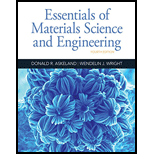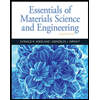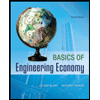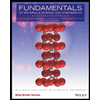
(a)
Interpretation:
The expected coordination number for
Concept Introduction:
The
Answer to Problem 3.85P
6 is the coordination number.
Explanation of Solution
For the selected elements the radii of atoms and ions from the table are given as,
The ratio of the radius is given as,
From the table the coordination number of
(b)
Interpretation:
The expected coordination number for UO2 compound is determined using the ionic radii in given B appendix.
Concept Introduction:
Uranium dioxide also called as Urania is black in color. This element is radioactive and powdered crystalline and it is found in the uraninite mineral. From the formula, UO2the cation is
Answer to Problem 3.85P
6 is the coordination number.
Explanation of Solution
For the selected elements the radii of atoms and ions from the table are given as,
The ratio of the radius is given as,
From the table the coordination number of UO2is given as 6
(c)
Interpretation:
The expected coordination number for BaO compound is determined using the ionic radii in given B appendix.
Concept Introduction:
The compound Barium oxide is non-flammable. It is white in color and the structure of the compound is cube. It is used in the crown glass, cathode ray tubes and catalyst. From the formula there will be 1 cation that is
Answer to Problem 3.85P
8 is the coordination number.
Explanation of Solution
For the selected elements the radii of atoms and ions from the table are given as,
The ratio of the radius is given as,
From the table the coordination number of BaO is given as 8
(d)
Interpretation:
The expected coordination number for
Concept Introduction:
The compound silicon nitride is a compound that is made of nitrogen and silicon. This chemical compound is stable
Answer to Problem 3.85P
4 is the coordination number.
Explanation of Solution
For the selected elements the radii of atoms and ions from the table are given as,
The ratio of the radius is given as,
From the table the coordination number of
(e)
Interpretation:
The expected coordination number for
Concept Introduction:
Answer to Problem 3.85P
4 is the coordination number.
Explanation of Solution
For the selected elements the radii of atoms and ions from the table are given as,
The ratio of the radius is given as,
From the table the coordination number of
(f)
Interpretation:
The expected coordination number for
Concept Introduction:
The
The ratio of radius of cation to anion can helps in determining the coordination number of the compound from table B in Appendix
Answer to Problem 3.85P
6 is the coordination number.
Explanation of Solution
For the selected elements the radii of atoms and ions from the table are given as,
The ratio of the radius is given as,
From the table B in Appendix, the coordination number of
(g)
Interpretation:
The expected coordination number for MgS compound is determined using the ionic radii in given B appendix.
Concept Introduction:
The MgS compound is inorganic and white in color. It accumulates in the impure form and it is made of crystalline material. In the impure form it is in the brown color and the material becomes non crystalline powder. From the formula, the cation is
Answer to Problem 3.85P
6 is the coordination number.
Explanation of Solution
For the selected elements the radii of atoms and ions from the table are given as,
The ratio of the radius is given as,
From the table the coordination number of MgS is given as 6
(h)
Interpretation:
The expected coordination number for KBr compound is determined using the ionic radii in given B appendix.
Concept Introduction:
Potassium bromide is the salt of ions and in the aqueous solution has pH 7 where it is completely dissociated. This compound is the bromide ions source. From the formula, the cation is
Answer to Problem 3.85P
6 is the coordination number.
Explanation of Solution
For the selected elements the radii of atoms and ions from the table are given as,
The ratio of the radius is given as,
From the table the coordination number of KBr is given as 6
Want to see more full solutions like this?
Chapter 3 Solutions
Essentials Of Materials Science And Engineering
 MATLAB: An Introduction with ApplicationsEngineeringISBN:9781119256830Author:Amos GilatPublisher:John Wiley & Sons Inc
MATLAB: An Introduction with ApplicationsEngineeringISBN:9781119256830Author:Amos GilatPublisher:John Wiley & Sons Inc Essentials Of Materials Science And EngineeringEngineeringISBN:9781337385497Author:WRIGHT, Wendelin J.Publisher:Cengage,
Essentials Of Materials Science And EngineeringEngineeringISBN:9781337385497Author:WRIGHT, Wendelin J.Publisher:Cengage, Industrial Motor ControlEngineeringISBN:9781133691808Author:Stephen HermanPublisher:Cengage Learning
Industrial Motor ControlEngineeringISBN:9781133691808Author:Stephen HermanPublisher:Cengage Learning Basics Of Engineering EconomyEngineeringISBN:9780073376356Author:Leland Blank, Anthony TarquinPublisher:MCGRAW-HILL HIGHER EDUCATION
Basics Of Engineering EconomyEngineeringISBN:9780073376356Author:Leland Blank, Anthony TarquinPublisher:MCGRAW-HILL HIGHER EDUCATION Structural Steel Design (6th Edition)EngineeringISBN:9780134589657Author:Jack C. McCormac, Stephen F. CsernakPublisher:PEARSON
Structural Steel Design (6th Edition)EngineeringISBN:9780134589657Author:Jack C. McCormac, Stephen F. CsernakPublisher:PEARSON Fundamentals of Materials Science and Engineering...EngineeringISBN:9781119175483Author:William D. Callister Jr., David G. RethwischPublisher:WILEY
Fundamentals of Materials Science and Engineering...EngineeringISBN:9781119175483Author:William D. Callister Jr., David G. RethwischPublisher:WILEY





